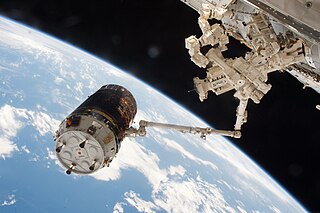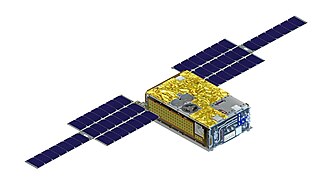Related Research Articles

Hydroxylammonium nitrate or hydroxylamine nitrate (HAN) is an inorganic compound with the chemical formula [NH3OH]+[NO3]−. It is a salt derived from hydroxylamine and nitric acid. In its pure form, it is a colourless hygroscopic solid. It has potential to be used as a rocket propellant either as a solution in monopropellants or bipropellants. Hydroxylammonium nitrate (HAN)-based propellants are a viable and effective solution for future green propellant-based missions, as it offers 50% higher performance for a given propellant tank compared to commercially used hydrazine.
The Small Demonstration Satellite (SDS) is a spacecraft or satellite which is built as part of a JAXA programme to develop and demonstrate technology for and through small satellites. One of the mid-term goals is also to demonstrate formation flying. SDS-1 launched aboard an H-IIA rocket on 23 January 2009, as a secondary payload to GOSAT. The operation finished successfully on September 8, 2010.

IKAROS is a Japan Aerospace Exploration Agency (JAXA) experimental spacecraft. The spacecraft was launched on 20 May 2010, aboard an H-IIA rocket, together with the Akatsuki probe and four other small spacecraft. IKAROS is the first spacecraft to successfully demonstrate solar sail technology in interplanetary space. The craft's name is an allusion to the legendary Icarus, who flew close to the Sun on wings made of bird-feathers and wax.

Busek Co. Inc. is an American spacecraft propulsion company that builds thrusters, electronics, and various systems for spacecraft.

The Epsilon Launch Vehicle, or Epsilon rocket, is a Japanese solid-fuel rocket designed to launch scientific satellites. It is a follow-on project to the larger and more expensive M-V rocket which was retired in 2006. The Japan Aerospace Exploration Agency (JAXA) began developing the Epsilon in 2007. It is capable of placing a 590 kg payload into Sun-synchronous orbit.

Kounotori 6 (こうのとり6号機), also known as HTV-6, was the sixth flight of the H-II Transfer Vehicle, an uncrewed cargo spacecraft launched to resupply the International Space Station. It was launched at 13:26:47 UTC on 9 December 2016 aboard H-IIB launch vehicle from Tanegashima Space Center.

Lunar IceCube is a NASA nanosatellite orbiter mission that was intended to prospect, locate, and estimate amount and composition of water ice deposits on the Moon for future exploitation. It was launched as a secondary payload mission on Artemis 1, the first flight of the Space Launch System (SLS), on 16 November 2022. As of February 2023 it's unknown whether NASA team has contact with satellite or not.

Smart Lander for Investigating Moon (SLIM) is a lunar lander mission of the Japan Aerospace Exploration Agency (JAXA). In 2017 the plan was for the lander to be launched in 2021, but this was postponed to 2023 because of delays in SLIM's ride share, the X-Ray Imaging and Spectroscopy Mission (XRISM). On 6 September 2023 at 23:42 UTC, XRISM successfully launched. SLIM separated from XRISM later that same day. On 1 October 2023 SLIM executed its trans-lunar orbit injection burns. The lander successfully entered lunar orbit on 25 December 2023 and landed on 19 January 2024 at 15:20 UTC, making Japan the fifth country to soft land on the surface of the Moon.

EQUULEUS is a nanosatellite of the 6U CubeSat format that will measure the distribution of plasma that surrounds the Earth (plasmasphere) to help scientists understand the radiation environment in that region. It will also demonstrate low-thrust trajectory control techniques, such as multiple lunar flybys, within the Earth-Moon region using water steam as propellant. The spacecraft was designed and developed jointly by the Japan Aerospace Exploration Agency (JAXA) and the University of Tokyo.
The Innovative Satellite Technology Demonstration Program is a series of spacecraft missions for testing technology and ideas put forward by universities and private companies. The program demonstrates various experimental devices and technology in space by providing flight opportunities. It is managed by the JAXA Research and Development Directorate. According to JAXA, the goal of this program is to test high risk, innovative technology that will lead to the space industry gaining competitiveness in the international field.
RAPIS-1 is a satellite launched on 18 January 2019 which for over a year was used to test seven technology demonstration projects. RAPIS-1 was developed and operated by Axelspace Corporation, under the coordination of the Japanese space agency JAXA.
AQT-D was a nanosatellite project of the University of Tokyo (UT) Space Propulsion Laboratory with the purpose of testing water-fueled propulsion. The satellite was a CubeSat of 3U size; 1U was occupied by the propulsion system, while the remaining 2U was for the spacecraft bus. AQT-D was carried to space inside the pressurized section of Kounotori 8, a Japanese resupply vehicle for the International Space Station (ISS). Kounotori 8 was launched on 24 September 2019. After arriving at the ISS, AQT-D was deployed to space on 20 November 2019 using the JEMRMS robotic arm at the space station's Kibō laboratory module.

ThrustMe is a deep tech company that designs miniaturized aerospace thrusters for small satellites, increasing the life of satellites and making them more affordable.
DRUMS is an experimental spacecraft that will test proximity operation near space debris. The microsatellite carries two 'mock space debris' which once deployed will be used as a target for demonstrating approach and contact.
ASTERISC is a nanosatellite developed by the Planetary Exploration Research Center (PERC) at the Chiba Institute of Technology that will observe cosmic dust in low Earth orbit. It is built as 3U-sized CubeSat and will deploy a large membrane structure in space. ASTERISC was launched on 9 November 2021 by an Epsilon launch vehicle.
KOSEN-1 is a technology demonstration satellite that will test the deployment of an antenna for observing radio waves emitted from the planet Jupiter. It is a 2U CubeSat, and carries a 7 m (23 ft) antenna. The CubeSat was jointly developed by the National Institute of Technologies in Japan. National Institute of Technologies is known as 'kosen' in Japanese. KOSEN-1 was launched on 9 November 2021 by an Epsilon launch vehicle, as part of the Innovative Satellite Technology Demonstration-2 mission.
RAISE-2 was a smallsat for technology demonstration, part of the Japanese space agency JAXA's Innovative Satellite Technology Demonstration Program. RAISE-2 was launched on 9 November 2021 as the main satellite of Innovative Satellite Technology Demonstration-2. RAISE-2 was developed by Mitsubishi Electric.
PETREL is a technology demonstration satellite being developed by Tokyo Institute of Technology. The microsatellite is equipped with a multispectral camera, which will be used to carry out two distinct missions. One mission is to survey the sky in ultraviolet wavelengths for the field of time-domain astronomy, and the other is to conduct spectroscopic observations of the Earth. PETREL is planned to be launched as part of the Japanese space agency JAXA's 2022 Innovative Satellite Technology Demonstration-3 mission.
Mitsuba was a nanosatellite developed by Kyushu Institute of Technology (Kyutech) which would have tested whether products that are not intended for use in space are still usable for satellites. Mitsuba was launched on 12 October 2022 by an Epsilon rocket, but the launch resulted in a failure and the satellite was lost.
KOSEN-2 is an educational nanosatellite jointly developed by eight schools of National Institute of Technology in Japan. The satellite would have tested IoT technologies in space. KOSEN-2 was launched on 12 October 2022 by an Epsilon rocket as part of the Innovative Satellite Technology Demonstration-3 mission, but the launch resulted in a failure and the satellite was lost.
References
- ↑ Navin, Joseph (11 October 2022). "JAXA Epsilon fails on sixth flight carrying RAISE-3 and others". NASASpaceFlight . Retrieved 12 October 2022.
- 1 2 "実証テーマ提案者の熱い思いに応えたい" (in Japanese). JAXA . Retrieved 2022-10-05.
- ↑ Nakamura, Shohei (15 February 2022). "SARセンサの開発方向性について" (PDF) (in Japanese). UTokyo-JAXA Center for Frontier Astronautics. Retrieved 2022-10-05.
- 1 2 "民生用GPUを活用し軌道上でのデータ処理実現を目指す" (in Japanese). JAXA . Retrieved 2022-10-05.
- 1 2 "水を推進剤とした超小型統合推進システムを軌道上実証する" (in Japanese). JAXA . Retrieved 2022-10-05.
- ↑ Asakawa, Jun; Koizumi, Hiroyuki; Yaginuma, Kazuya; Nakagawa, Yuichi (6 August 2022). "Pre-Flight Testing Results of Multiple Water Propulsion Systems – Resistojet and Ion Thruster for SmallSats". Utah State University . Retrieved 2022-10-05.
- ↑ "宇宙空間で膜を展開し、大気抵抗を用いたデオービット機構を実証する" (in Japanese). JAXA . Retrieved 2022-10-05.